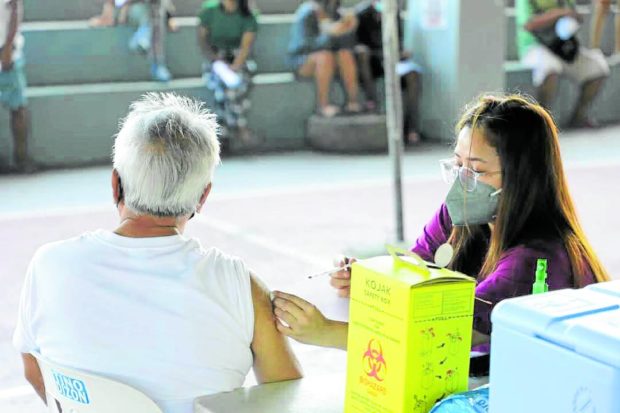
PROTECTED An elderly resident of City of San Fernando in Pampanga province receives his COVID-19 booster shot at a covered court as the local government began its village-based inoculation programon Monday to decongest the city’s major inoculation sites. —PHOTO COURTESY OF CITY OF SAN FERNANDO GOVERNMENT
CITY OF MALOLOS—While the number of new COVID-19 cases is rising in several localities outside the National Capital Region, the province of Bulacan and some areas in Pampanga are experiencing a declining number of caseloads.
Bulacan’s active infections have gone down by almost half in less than two weeks, local data showed on Thursday. The province’s current active cases stood at 5,549 compared to 10,551 on Jan. 17.
At least 4,953 of these patients were on home isolation, 542 were in the hospitals while 81 were taken to quarantine facilities, data from the provincial health office showed.
Gov. Daniel Fernando said the province, which is under alert level 3, could start easing quarantine restrictions under the lower alert level 2 by February due to the downward trend in new COVID-19 cases.
“Since we are anticipating fewer new COVID-19 cases in the coming days, we’re expecting that [in-person] classes will begin by June,” Fernando told the Inquirer in an interview on Thursday.
But Fernando said all grade school children must be fully vaccinated first against COVID-19 before they would be allowed to return to their classrooms.
Since the pandemic struck in 2020, Bulacan has already registered 106,939 COVID-19 cases with 100,420 recoveries and 1,517 deaths.
Village-based vaccination
In Pampanga province, the active COVID-19 cases in the capital city of San Fernando had gone down by 346 in the past four days, the city government disclosed on Thursday.
In its latest update on Thursday, the city government said the active cases stood at 1,434 from 1,780 on Jan. 23, its highest this year.
The city registered 89 new cases, 215 recoveries and zero deaths on Thursday. A day earlier, it recorded 91 new cases, 221 recoveries and no deaths.
Since the pandemic started in 2020, San Fernando has registered a total of 13,929 COVID-19 cases with 12,162 recoveries and 333 deaths.
The city government has established village-based vaccination areas to inoculate as many residents as possible and to decongest its vaccination sites.
Declining Adar
In Angeles City, the average daily attack rate (Adar) was already decreasing and the positivity rate suggested that the trajectory was downward from Jan. 20 to Jan. 26, according to independent research group OCTA.
Data obtained by OCTA showed that the one-week Adar in Angeles dropped from 35 to 33 per 100,000 population between Jan. 13 and Jan. 26. Adar refers to the number of individuals found infected for every 100,000 people.
The city’s seven-day positivity rate was also down from 53 percent to 43 percent during the same period.
But OCTA said Angeles’ COVID-19 risk level remained very high despite the declining number of risk indicators.
The health-care utilization rate in the city was still low at 32 percent as of Wednesday, OCTA said. —CARMELA REYES-ESTROPE AND JUN MALIG